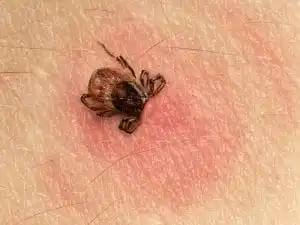During the warmer weather we take to fields, forests, and other outdoor oases to relax and have fun. But the great outdoors–and even our yards–are also where ticks call home. These blood-sucking bugs are most active during the spring and summer months, just when we become more active outdoors. They hide out in tall grasses, trees, and shrubs, waiting for a passing animal or human. Then ticks attach themselves and feed freely over a period of time. For the most part, tick bites are usually harmless. But in some cases, ticks can deliver dangerous diseases like Rocky mountain spotted fever, tularemia, ehrlichiosis, and the most notorious, Lyme disease. We’ll teach you how to identify a tick bite so you can keep you, your family, and pets safe from harm.
Identifying a Tick
Related to spiders, these parasitic pests are eight-legged arachnids that come in different shades of brown, reddish brown, and black. And although they range in size from smaller than a pinhead to as big as a pencil eraser, ticks get larger as they feed on blood, sometimes becoming as big as a marble. At this point they may be greenish or blue in color.
Caught in the Act
Many symptoms of tick-borne diseases don’t show up right away, but rather in a couple days to a few weeks. Fortunately, tick bites are easy to identify because the culprit is usually still attached to the skin and feeding. These pesky parasites sometimes stick around for days or weeks at a time. And because it takes at least 12 hours of feeding time before most tick-borne illnesses are transmitted, that gives us an opportunity to get rid of the bug before it bugs us.
Where to Look
First, you need to know where to look. Although these parasites are perfectly happy feeding anywhere on your body, they prefer warm, moist locations, so the first places to check are the groin area and armpits. The next place to check is the scalp or any areas that have hair, since the hair provides a perfect hideaway for pests. Ticks love to target the area around or behind the ears, so be sure to check there on both humans and pets. Once they find the feeding spot they want, they bite into the skin and begin sucking blood.
How to Identify a Tick Bite
It’s possible that the tick fell off or dropped off after it finished feeding, so it’s good to know what to look for when the tick isn’t present. Within a few days after you’ve been bitten, you may see a single, red spot about a half inch in size. The redness is an allergic reaction to the tick’s saliva. Because tick bites can look like other bug bites, such as mosquito, it’s important to keep track of anything that looks suspicious. Examine the bite often during the next 36 hours to see if it expands or becomes more red or raised. And definitely note if it takes on the appearance of a bull’s eye, since this circle around the bite is a surefire symptom that a tick has been feeding.
Signs and Symptoms of a Tick-Borne Illness
Once you’ve identified the bite, be sure to seek medical attention if you experience any of these symptoms:
- Red rash near the bite area
- Fever or chills
- Fatigue
- Headaches
- Nausea
- Aches, pains, or weaknesses in joints or muscles
- Swollen lymph nodes
Preventing Tick-Borne Illnesses
When you spend a lot of time outdoors, it’s a good idea to check yourself–and your pets–regularly. This way you can sometimes catch the creatures before they start feeding, and then brush them off of your clothes or remove them from your skin before they bite. If you remove the tick yourself, make sure to clean the bite area with alcohol. You can save the tick in a small jar or plastic bag and have it identified by a professional.
To get rid of ticks or other pests, or to find out how to prevent an infestation in your yard, contact Free Spray Lawn Care at 419-529-5296. We can help you determine the proper method of treatment and eradicate the pests once and for all.



Comments (0)
Thanks for your comment!
Thanks for your feedback! Your comments have been successfully submitted! Please note, all comments require admin approval prior to display.
Error submitting comment!
There is a problem with your comment, please see below and try again.